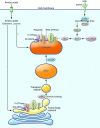Kidney growth and hypertrophy: the role of mTOR and vesicle trafficking
- PMID: 25985272
- PMCID: PMC4497766
- DOI: 10.1172/JCI81508
Kidney growth and hypertrophy: the role of mTOR and vesicle trafficking
Erratum in
-
Kidney growth and hypertrophy: the role of mTOR and vesicle trafficking.J Clin Invest. 2015 Aug 3;125(8):3304. doi: 10.1172/JCI83542. Epub 2015 Aug 3. J Clin Invest. 2015. PMID: 26237046 Free PMC article. No abstract available.
Abstract
The kidney, like other organs, grows in constant proportion to the rest of the body. When one kidney is removed, the remaining one hypertrophies. In a comprehensive series of studies, Chen et al. show that growth during maturation is mediated by the mTORC1 signaling pathway, which is induced by EGF-like peptides, and requires PI3K, PDK, AKT, mTORC2, and activation of mTORC1 through the combined effects of TSC and RHEB as part of a multiprotein complex localized on lysosomes. However, compensatory growth is mediated by amino acids, which act on mTORC1 independently of the previous pathway, and requires a class III PI3K (VPS34) that is known to be involved in vesicle trafficking to the lysosomes.
Figures

Comment on
-
Phosphatidylinositol 3-kinase signaling determines kidney size.J Clin Invest. 2015 Jun;125(6):2429-44. doi: 10.1172/JCI78945. Epub 2015 May 18. J Clin Invest. 2015. PMID: 25985273 Free PMC article.
References
-
- Smith HW. Renal function in infancy and childhood. In: Smith HW. The Kidney: Structure and Function in Health and Disease. New York, New York, USA: Oxford University Press; 1951:492–519.
-
- Oliver J. Nephrons and Kidneys. New York, New York, USA: Hoeber Medical Division of Harper and Row; 1968.
-
- Oliver J. New directions in renal morphology: a method, its results and its future. Harvey Lect. 1944–1945;40:102–155.
Publication types
MeSH terms
Substances
LinkOut - more resources
Full Text Sources
Medical
Miscellaneous

